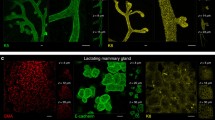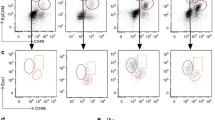Abstract.
The fate of dividing mouse mammary epithelial cells was followed by use of tritiated thymidine (3H-Tdr) autoradiography. Loss of label consistent with halving kinetics was observed at various times after injection; however, heavily labelled cells were frequently observed at two weeks and later, when none was expected. The grain count over these heavily labelled cells was often comparable with that 1 h after 3H-Tdr injection. Extensive serial sectioning revealed that the heavily labelled cells were often single cells surrounded by many unlabelled cells or that their label was in stark contrast (in excess of 20 reduced silver grains) to the surrounding group of cells whose label was just above background (a maximum of 3 grains). In addition, by injecting mice at different stages of oestrus, we demonstrated that these long-lived cells, although influenced by oestrus, replicated independently of the oestrogen peak. Our data support a model for mouse mammary epithelium that has a single ’stem’ cell positioned within a group of its progeny to form a discrete proliferative unit. This model requires many such stem cells within the mammary epithelium and is consistent with similar models proposed for other tissues.
Similar content being viewed by others
Author information
Authors and Affiliations
Additional information
Received: 10 January 1996 / Accepted 21 June 1996
Rights and permissions
About this article
Cite this article
Zeps, N., Dawkins, H., Papadimitriou, J. et al. Detection of a population of long-lived cells in mammary epithelium of the mouse. Cell Tissue Res 286, 525–536 (1996). https://doi.org/10.1007/s004410050722
Issue Date:
DOI: https://doi.org/10.1007/s004410050722




